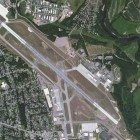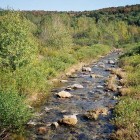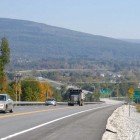Essex, Vermont
DuBois & King provided site identification and viability, evaluation, planning, and design services for a wetland mitigation site to compensate for impacts associated with a 16.7-mile limited access highway on a new alignment in Chittenden County. The project team located a site adjacent to the planned highway. The identified compensatory area had marginal wetland and wildlife habitat function and values. The D&K team developed a design for the wetland that significantly increased the functions and values of the site. Design for the site resulted in a sustainable ecosystem by:
De-channelizing highway runoff, decreasing energy/erosion potential
Increasing treatment of the highway runoff, improving water quality
Reducing the temperature of runoff, improving water quality
Increasing the diversity of wetland, aquatic, and wildlife habitat
Designing the site to function during periods of drought or flood
The project consisted of converting a 7.7-acre field into a wetland. A diversion channel/level spreader was designed along the upslope of the mitigation site. Drainage from approximately 90 acres of upland area is collected and directed into the level spreader. The result of de-channelizing the runoff and allowing it to sheet flow across the upper reaches of the site sufficiently altered the hydrology in the existing hydric soils to support a scrub-shrub wetland. At the base of the steeper terrain, a 1.1-acre marsh was created through excavation. The marsh varies in depth, with the majority averaging between 12 to 18 inches. A 1/8-acre pool, 4 to 5 ft deep, within the marsh provides winter habitat for wildlife such as frogs and turtles. An outlet channel was designed from the marsh to control water levels and divert runoff to the existing drainage channel and culvert under the Central Vermont Railroad. A complete planting plan was developed to speed up and enhance the wetland conversion. DuBois & King provided supervision of the planting program and inspection services for compliance with Army Corps of Engineers requirements.
Services provided include site selection, topographic survey, subsurface/soils evaluations, groundwater monitoring, hydrologic/hydraulic analyses, impoundment structure design, preparation of construction plans and special provision, landscape design, quantity takeoff, and cost estimates.



